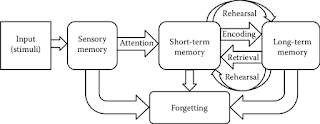eLearning
Atkinson & Shiffrin – Memory matters… three-stage model of memory…
Author: Donald Clark
Go to Source
As memory research moved away from the purely behaviourist, stimulus- response (S-R) model, and its offspring the stimulus- organism -response (S-O-R), psychologists started to think of memory in term of information processing. This proved to be useful in determining models for memory, models that could be tested in laboratory experiments. Although distinctions between different types of memory had been present in the literature, Atkinson & Shiffrin, in 1968, laid down the first solid model for memory that acted as a solid foundation for further research and refinement.
Three-stage model
This first, sophisticated stage model, starts with input through our eyes, ears and other sense organs, to the sensory register, where representational copies are created. For images and sound, the sensory register has ‘iconic’ memory for images and ‘echoic’ memory for sound. That feeds, through attention, into STM (Short-Term Memory), a temporary store which has a 15-30 second passing window of consciousness, and if not noticed, the content decays.
However, STM memories can be moved into LTM (Long-Term Memory) through rehearsal and encoding, to be retrieved later.
Critique
The model has been criticised as being too rigid, linear and ignoring the different types of presented memories and has indeed been supplanted by other models and, more recently, dynamic descriptions of memory that rely less on information processing models. For example, a simplified version of the model SAM (Search of Associative Memory) has been proposed which drops the sensory store leaving just a buffer STM and LTM (Raaijmakers & Shiffrin, 1981). Strong ‘recency’ effects support this, as we remember the last thing in STM more clearly.
Influence
Memory is a necessary condition for learning, yet not enough teachers, lecturers and instructors know even the basic psychology of memory. Learning theory is, to a large extend the study of what goes on inside the mind and that is largely dependent on memory. This model may not wholly reflect the complexities of memory but it makes useful distinctions and attempts to explain how memories move from one state to another for subsequent retention and recall, the aim of most education. Having climbed inside the mind, unpacking the structure and process of memory, especially the distinction between short and long-term memory was useful. The Atkinson-Shiffrin model stimulated intense and fruitful research on memory.
Bibliography
Atkinson & Shiffrin Human Memory: A proposed system and its control process in Spence, K. W., & Spence, J. T. (1968).The Psychology of learning and motivation: Advances in theory and research. New York: Academic Press.


